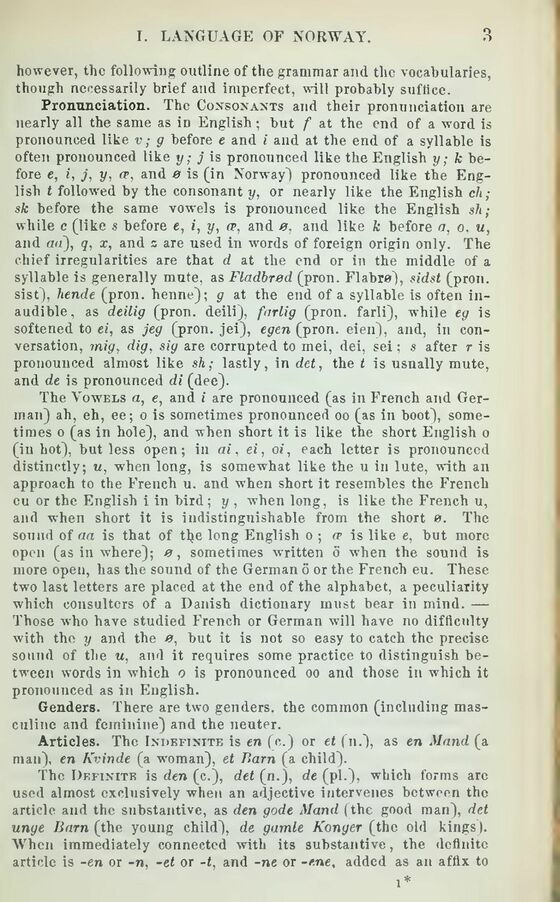
Full resolution (JPEG) - On this page / på denna sida - Sketch of Norwegian and Swedish Grammar, with Vocabulary and List of Phrases - I. The Language of Norway - Pronunciation - Genders - Articles

<< prev. page << föreg. sida << >> nästa sida >> next page >>
Below is the raw OCR text
from the above scanned image.
Do you see an error? Proofread the page now!
Här nedan syns maskintolkade texten från faksimilbilden ovan.
Ser du något fel? Korrekturläs sidan nu!
This page has never been proofread. / Denna sida har aldrig korrekturlästs.
however, the following outline of the grammar and the vocabularies,
though necessarily brief and imperfect, will probably suffice.
Pronunciation. The Consonants and their pronunciation are
nearly all the same as iD English; but f at the end of a word is
pronounced like v; g before e and i and at the end of a syllable is
often pronounced like y; j is pronounced like the English y; k
before e, i, j, y, ee, and 0 is (in Norway"] pronounced like the
English t followed by the consonant y, or nearly like the English ch;
sk before the same vowels is pronounced like the English sh;
while c (like s before e, i, y, a, and 0. and like k before a, 0, u,
and aa~), q, x, and s are used in words of foreign origin only. The
chief irregularities are that d at the end or in the middle of a
syllable is generally mute, as Fladbred (pron. Flabre), sidst (pron.
sist), hende (pron. henne); g at the end of a syllable is often
inaudible, as deilig (pron. deili), farlig (pron. farli), while eg is
softened to ei, as jeg (pron. jei), egen (pron. eien), and, in
conversation, mig, dig, sig are corrupted to mei, dei, sei; s after r is
pronounced almost like sh; lastly, in det, the t is usnally mute,
and de is pronounced di (dee).
The Vowels a, e, and i are pronounced (as in French and
German) ah, eh, ee; 0 is sometimes pronounced 00 (as in hoot),
sometimes 0 (as in hole), and when short it is like the short English 0
(in hot), but less open; in ai, ei, oi, each letter is pronounced
distinctly; u, when long, is somewhat like the u in lute, with an
approach to the French u. and when short it resembles the French
cu or the English i in bird; y , when long, is like the French u,
and when short it is indistinguishable from the short 0. The
sound of aa is that of tlje long English 0 ; ce is like e, but more
open (as in where); 0, sometimes written ö when the sound is
more open, has the sound of the German ö or the French eu. These
two last letters are placed at the end of the alphabet, a peculiarity
which consultcrs of a Danish dictionary must bear in mind. —
Those who have studied French or German will have no difficulty
with the y and the 0, but it is not so easy to catch the precise
sound of the tt, and it requires some practice to distinguish
between words in which 0 is pronounced 00 and those in which it
pronounced as in English.
Genders. There are two genders, the common (including
masculine and feminine) and the neuter.
Articles. The Indefinite is en (0.) or et (n.), as en Mand (a
man), en Kvinde (a woman), et Barn (a child).
The Definite is den (c.), det (n.), de (pi.), which forms arc
used almost exclusively when an adjective intervenes between the
article and the substantive, as den gode Mand (the good man), det
unge Barn (the young child), de gamle Konger (the old kings).
When immediately connected with its substantive, the definite
article is -en or -n, -et or -t, and -ne or -ene, added as an affix to
<< prev. page << föreg. sida << >> nästa sida >> next page >>